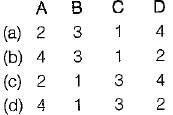All Exams >
Electronics and Communication Engineering (ECE) >
Communication System >
All Questions
All questions of Angle Modulation: Analog Communication for Electronics and Communication Engineering (ECE) Exam
According to Carson’s rule, the bandwidth of FM wave is given by (Aω is the frequency deviation and ωm the modulating frequency)- a)(Δω + ωm)
- b)(Δω + 2ωm)
- c)2(Δω + ωm)
- d)(2Δω + ωm)
Correct answer is option 'C'. Can you explain this answer?
According to Carson’s rule, the bandwidth of FM wave is given by (Aω is the frequency deviation and ωm the modulating frequency)
a)
(Δω + ωm)
b)
(Δω + 2ωm)
c)
2(Δω + ωm)
d)
(2Δω + ωm)
|
|
Luminary Institute answered |
According to Carson’s rule, the bandwidth of a single-tone wideband FM is
BW = 2(Δω + ωm)
BW = 2(Δω + ωm)
Consider the following statements associated with angle modulations:
1. In FM, the frequency deviation is proportional to modulating frequency.
2. In PM, the frequency deviation is independent of modulating signal.
3. Amplitude of both FM and PM are constant.
4. It is possible to receive FM on a PM receiver and vice-versa.
5. Signal to noise ratio of PM is better than that of FM.
Which of the statements given above are correct?- a)2 and 5 only
- b)3 and 4 only
- c)1, 4 and 5
- d)2, 3 and 4
Correct answer is option 'B'. Can you explain this answer?
Consider the following statements associated with angle modulations:
1. In FM, the frequency deviation is proportional to modulating frequency.
2. In PM, the frequency deviation is independent of modulating signal.
3. Amplitude of both FM and PM are constant.
4. It is possible to receive FM on a PM receiver and vice-versa.
5. Signal to noise ratio of PM is better than that of FM.
Which of the statements given above are correct?
1. In FM, the frequency deviation is proportional to modulating frequency.
2. In PM, the frequency deviation is independent of modulating signal.
3. Amplitude of both FM and PM are constant.
4. It is possible to receive FM on a PM receiver and vice-versa.
5. Signal to noise ratio of PM is better than that of FM.
Which of the statements given above are correct?
a)
2 and 5 only
b)
3 and 4 only
c)
1, 4 and 5
d)
2, 3 and 4

|
Uday Kumar answered |
• In FM, the frequency deviation is proportional only to the amplitude variation of the modulating signal and it is independent of modulating frequency fm. Hence, statement-1 is not correct.
• In PM, the frequency deviation increases with increase in modulating frequency fm and decreases with decrease in modulating frequency. Thus, frequency deviation in PM is proportional to modulating frequency. Hence, statement-2 is false.
• Statement-3 is correct.
• it is possible to receive FM on a PM receiver and PM on a FM receiver. Hence, statement-4 is correct.
• Signal to noise ratio of PM is inferior to that in FM. Hence, statement-5 is not correct.
• In PM, the frequency deviation increases with increase in modulating frequency fm and decreases with decrease in modulating frequency. Thus, frequency deviation in PM is proportional to modulating frequency. Hence, statement-2 is false.
• Statement-3 is correct.
• it is possible to receive FM on a PM receiver and PM on a FM receiver. Hence, statement-4 is correct.
• Signal to noise ratio of PM is inferior to that in FM. Hence, statement-5 is not correct.
Determine the bandwidth required for an FM signal having frequency 2 kHz and maximum deviation 10 kHz. - a)16 kHz
- b)32 kHz
- c)24 kHz
- d)8 kHz
Correct answer is option 'C'. Can you explain this answer?
Determine the bandwidth required for an FM signal having frequency 2 kHz and maximum deviation 10 kHz.
a)
16 kHz
b)
32 kHz
c)
24 kHz
d)
8 kHz
|
|
Kavya Singhania answered |
To determine the bandwidth required for an FM signal, we need to consider the frequency of the signal and the maximum deviation. In frequency modulation (FM), the instantaneous frequency of the carrier signal is varied according to the modulating signal.
Frequency Modulation (FM):
FM is a modulation technique where the frequency of the carrier signal is varied in proportion to the instantaneous amplitude of the modulating signal. This modulation technique is widely used in applications such as radio broadcasting.
Maximum Deviation:
The maximum deviation represents the maximum change in frequency from the carrier frequency. In FM, it is the maximum frequency shift that occurs due to modulation. It is usually measured in kilohertz (kHz).
Given parameters:
Frequency of the FM signal = 2 kHz
Maximum deviation = 10 kHz
Calculation:
The bandwidth required for an FM signal can be calculated by using Carson's rule:
Bandwidth = 2 × (maximum deviation + modulating frequency)
In this case, the modulating frequency is 2 kHz and the maximum deviation is 10 kHz.
Bandwidth = 2 × (10 kHz + 2 kHz)
= 2 × 12 kHz
= 24 kHz
Therefore, the bandwidth required for the FM signal is 24 kHz.
Conclusion:
The correct answer is option 'C' - 24 kHz. The bandwidth required for an FM signal with a frequency of 2 kHz and a maximum deviation of 10 kHz is 24 kHz.
Frequency Modulation (FM):
FM is a modulation technique where the frequency of the carrier signal is varied in proportion to the instantaneous amplitude of the modulating signal. This modulation technique is widely used in applications such as radio broadcasting.
Maximum Deviation:
The maximum deviation represents the maximum change in frequency from the carrier frequency. In FM, it is the maximum frequency shift that occurs due to modulation. It is usually measured in kilohertz (kHz).
Given parameters:
Frequency of the FM signal = 2 kHz
Maximum deviation = 10 kHz
Calculation:
The bandwidth required for an FM signal can be calculated by using Carson's rule:
Bandwidth = 2 × (maximum deviation + modulating frequency)
In this case, the modulating frequency is 2 kHz and the maximum deviation is 10 kHz.
Bandwidth = 2 × (10 kHz + 2 kHz)
= 2 × 12 kHz
= 24 kHz
Therefore, the bandwidth required for the FM signal is 24 kHz.
Conclusion:
The correct answer is option 'C' - 24 kHz. The bandwidth required for an FM signal with a frequency of 2 kHz and a maximum deviation of 10 kHz is 24 kHz.
A phase modulated signal can be obtained from frequency modulator by passing the modulating signal through a- a)Differentiator
- b)Integrator
- c)High pass filter
- d)None of these
Correct answer is option 'A'. Can you explain this answer?
A phase modulated signal can be obtained from frequency modulator by passing the modulating signal through a
a)
Differentiator
b)
Integrator
c)
High pass filter
d)
None of these
|
|
Ojasvi Khurana answered |
Explanation:
Differentiator:
- A differentiator is a circuit that produces an output voltage proportional to the rate of change of the input voltage.
- When a modulating signal is passed through a differentiator, it enhances the high-frequency components in the signal.
- This results in the modulation index of the frequency modulated signal being directly proportional to the rate of change of the modulating signal.
Phase Modulated Signal:
- In phase modulation, the phase of the carrier signal is varied in accordance with the modulating signal.
- This results in a change in the phase of the carrier signal which carries the information.
Obtaining Phase Modulated Signal:
- By passing the modulating signal through a differentiator before feeding it to the frequency modulator, we can obtain a phase modulated signal.
- The differentiator enhances the high-frequency components in the modulating signal, which in turn affects the phase of the carrier signal in the frequency modulator.
Differentiator:
- A differentiator is a circuit that produces an output voltage proportional to the rate of change of the input voltage.
- When a modulating signal is passed through a differentiator, it enhances the high-frequency components in the signal.
- This results in the modulation index of the frequency modulated signal being directly proportional to the rate of change of the modulating signal.
Phase Modulated Signal:
- In phase modulation, the phase of the carrier signal is varied in accordance with the modulating signal.
- This results in a change in the phase of the carrier signal which carries the information.
Obtaining Phase Modulated Signal:
- By passing the modulating signal through a differentiator before feeding it to the frequency modulator, we can obtain a phase modulated signal.
- The differentiator enhances the high-frequency components in the modulating signal, which in turn affects the phase of the carrier signal in the frequency modulator.
Consider the FM signal xc(t) = 10 cos(2π × 108t + 0.5 sin(104 πt)). The bandwidth of xc(t) is approximately- a)2 kHz
- b)100 MHz
- c)15 kHz
- d)6 kHz
Correct answer is option 'C'. Can you explain this answer?
Consider the FM signal xc(t) = 10 cos(2π × 108t + 0.5 sin(104 πt)). The bandwidth of xc(t) is approximately
a)
2 kHz
b)
100 MHz
c)
15 kHz
d)
6 kHz
|
|
Tanvi Ahuja answered |
Π(10^6)t + 2 cos(2π(10^3)t) + cos(2π(10^4)t).
To determine the bandwidth of this FM signal, we need to consider the highest frequency component present in the signal. In this case, the highest frequency component is 10^4 Hz.
The bandwidth of an FM signal can be approximated using Carson's rule, which states that the bandwidth is equal to 2 times the sum of the highest frequency component and the peak frequency deviation.
In this case, the peak frequency deviation can be determined by taking the difference between the highest frequency component and the carrier frequency. The carrier frequency is given as 10^6 Hz.
Therefore, the peak frequency deviation is 10^4 Hz - 10^6 Hz = -9 x 10^3 Hz.
Using Carson's rule, the bandwidth of the FM signal is approximately 2(10^4 Hz + 9 x 10^3 Hz) = 38 x 10^3 Hz or 38 kHz.
To determine the bandwidth of this FM signal, we need to consider the highest frequency component present in the signal. In this case, the highest frequency component is 10^4 Hz.
The bandwidth of an FM signal can be approximated using Carson's rule, which states that the bandwidth is equal to 2 times the sum of the highest frequency component and the peak frequency deviation.
In this case, the peak frequency deviation can be determined by taking the difference between the highest frequency component and the carrier frequency. The carrier frequency is given as 10^6 Hz.
Therefore, the peak frequency deviation is 10^4 Hz - 10^6 Hz = -9 x 10^3 Hz.
Using Carson's rule, the bandwidth of the FM signal is approximately 2(10^4 Hz + 9 x 10^3 Hz) = 38 x 10^3 Hz or 38 kHz.
An angle modulated signal with carrier frequency ωc = 2π × 106 rad/s given by ϕm(t) = cos(ωct + 5 sin (1000πt) + 10 sin (2000πt)). The maximum deviation of the frequency in the angle modulated signal from that of the carrier is ___________ kHz.
Correct answer is between '12,13'. Can you explain this answer?
An angle modulated signal with carrier frequency ωc = 2π × 106 rad/s given by ϕm(t) = cos(ωct + 5 sin (1000πt) + 10 sin (2000πt)). The maximum deviation of the frequency in the angle modulated signal from that of the carrier is ___________ kHz.
|
|
Sarita Yadav answered |
Given:
The angle modulated signal is given by
ϕm(t) = cos(ωct + 5 sin (1000πt) + 10 sin (2000πt))
instantaneous frequency

Where ϕt is the phase of angle modulated signal.

In the above expression
fc is the carrier frequency and additional term is the deviation (2500 cos 1000πt + 10, 000 cos cos 2000 πt)
fd = 2500 cos 1000πt + 10, 000 cos cos 2000 πt
(fD)max = max (2500 cos 1000πt + 10, 000 cos cos 2000 πt)
(fD)max = (2500 + 10, 000)Hz = 12.5 kHz
The angle modulated signal is given by
ϕm(t) = cos(ωct + 5 sin (1000πt) + 10 sin (2000πt))
instantaneous frequency

Where ϕt is the phase of angle modulated signal.

In the above expression
fc is the carrier frequency and additional term is the deviation (2500 cos 1000πt + 10, 000 cos cos 2000 πt)
fd = 2500 cos 1000πt + 10, 000 cos cos 2000 πt
(fD)max = max (2500 cos 1000πt + 10, 000 cos cos 2000 πt)
(fD)max = (2500 + 10, 000)Hz = 12.5 kHz
Which is true in a frequency modulated system ?- a)Variation of carrier amplitude does not affect quality of reception
- b)Amplitude of carrier is varied according to modulating signal
- c)The transmission does not require line of sight between transmitter and reciever
- d)Receiver uses diode detector
Correct answer is option 'A'. Can you explain this answer?
Which is true in a frequency modulated system ?
a)
Variation of carrier amplitude does not affect quality of reception
b)
Amplitude of carrier is varied according to modulating signal
c)
The transmission does not require line of sight between transmitter and reciever
d)
Receiver uses diode detector
|
|
Rajat Kapoor answered |
Variation of carrier amplitude does not affect quality of reception
Explanation:
Frequency modulation (FM) is a modulation technique used in electronic communication, most commonly for transmitting information via a carrier wave by varying the frequency of the carrier wave in proportion to the instantaneous amplitude of the modulating signal.
In a frequency modulated system, the variation of the carrier amplitude does not affect the quality of reception. This is because FM is a form of angle modulation, where the information is encoded in the change of frequency, rather than the amplitude of the carrier wave.
Here are the key points explaining why the statement is true:
1. Amplitude vs Frequency Modulation:
- In amplitude modulation (AM), the amplitude of the carrier wave is varied in proportion to the instantaneous amplitude of the modulating signal. Changes in the carrier amplitude directly affect the quality of reception in AM systems.
- In frequency modulation (FM), on the other hand, the frequency of the carrier wave is varied in proportion to the instantaneous amplitude of the modulating signal. The amplitude of the carrier wave remains constant, and only the frequency changes.
2. Benefits of Frequency Modulation:
- FM has several advantages over AM, including better noise immunity, improved signal-to-noise ratio, and higher fidelity.
- The constant amplitude of the carrier wave in FM ensures that the received signal is less susceptible to amplitude variations caused by noise or interference.
3. Receiver Operation:
- In an FM system, the receiver uses a frequency discriminator to recover the modulating signal from the received frequency-modulated waveform.
- The receiver does not rely on variations in the carrier amplitude to extract the information. Instead, it focuses on detecting and measuring the changes in the carrier frequency.
- The diode detector mentioned in option 'D' is commonly used in amplitude demodulation (AM) systems, not frequency modulation (FM) systems.
Conclusion:
In summary, the statement that the variation of carrier amplitude does not affect the quality of reception in a frequency modulated system is true. FM systems rely on changes in frequency rather than amplitude, and the receiver uses a frequency discriminator to recover the modulating signal.
Explanation:
Frequency modulation (FM) is a modulation technique used in electronic communication, most commonly for transmitting information via a carrier wave by varying the frequency of the carrier wave in proportion to the instantaneous amplitude of the modulating signal.
In a frequency modulated system, the variation of the carrier amplitude does not affect the quality of reception. This is because FM is a form of angle modulation, where the information is encoded in the change of frequency, rather than the amplitude of the carrier wave.
Here are the key points explaining why the statement is true:
1. Amplitude vs Frequency Modulation:
- In amplitude modulation (AM), the amplitude of the carrier wave is varied in proportion to the instantaneous amplitude of the modulating signal. Changes in the carrier amplitude directly affect the quality of reception in AM systems.
- In frequency modulation (FM), on the other hand, the frequency of the carrier wave is varied in proportion to the instantaneous amplitude of the modulating signal. The amplitude of the carrier wave remains constant, and only the frequency changes.
2. Benefits of Frequency Modulation:
- FM has several advantages over AM, including better noise immunity, improved signal-to-noise ratio, and higher fidelity.
- The constant amplitude of the carrier wave in FM ensures that the received signal is less susceptible to amplitude variations caused by noise or interference.
3. Receiver Operation:
- In an FM system, the receiver uses a frequency discriminator to recover the modulating signal from the received frequency-modulated waveform.
- The receiver does not rely on variations in the carrier amplitude to extract the information. Instead, it focuses on detecting and measuring the changes in the carrier frequency.
- The diode detector mentioned in option 'D' is commonly used in amplitude demodulation (AM) systems, not frequency modulation (FM) systems.
Conclusion:
In summary, the statement that the variation of carrier amplitude does not affect the quality of reception in a frequency modulated system is true. FM systems rely on changes in frequency rather than amplitude, and the receiver uses a frequency discriminator to recover the modulating signal.
In a FM system, the modulating frequency fm = 1 kHz, the modulating voltage Vm= 2 volt and the deviation is 6 kHz. If the modulating voltage is raised to 4 volt then what is the new deviation?- a)4 kHz
- b)6 kHz
- c)8 kHz
- d)12 kHz
Correct answer is option 'D'. Can you explain this answer?
In a FM system, the modulating frequency fm = 1 kHz, the modulating voltage Vm= 2 volt and the deviation is 6 kHz. If the modulating voltage is raised to 4 volt then what is the new deviation?
a)
4 kHz
b)
6 kHz
c)
8 kHz
d)
12 kHz

|
Diya Chopra answered |
Given, 
We know that,

or,

When, V'm = 4 V, the new deviation in frequency is


We know that,

or,

When, V'm = 4 V, the new deviation in frequency is

In a frequency modulation system, maximum frequency deviation allowed is 1000 and modulating frequency is 1 kHz. Determine modulation index β.- a)2
- b)2000
- c)1
- d)1000
Correct answer is option 'C'. Can you explain this answer?
In a frequency modulation system, maximum frequency deviation allowed is 1000 and modulating frequency is 1 kHz. Determine modulation index β.
a)
2
b)
2000
c)
1
d)
1000
|
|
Sarita Yadav answered |
Concept:
In FM (Frequency Modulation), the modulation index is defined as the ratio of frequency deviation to the modulating frequency.
Mathematically, this is defined as:

mf = Modulation index
Δf = Frequency deviation
fm = Modulating frequency
In FM (Frequency Modulation), the modulation index is defined as the ratio of frequency deviation to the modulating frequency.
Mathematically, this is defined as:

mf = Modulation index
Δf = Frequency deviation
fm = Modulating frequency
Calculation:
Given Δf = 1000 Hz = 1 kHz
fm = 1 kHz

Given Δf = 1000 Hz = 1 kHz
fm = 1 kHz

The four basic elements in a PLL are loop filter, loop amplifier, VCO and- a)Up converter
- b)Down converter
- c)Phase detector
- d)Frequency multiplier
Correct answer is option 'C'. Can you explain this answer?
The four basic elements in a PLL are loop filter, loop amplifier, VCO and
a)
Up converter
b)
Down converter
c)
Phase detector
d)
Frequency multiplier
|
|
Luminary Institute answered |
- A phase-locked loop is a control system that generates an output signal whose phase is related to the phase of an input signal.
- The circuit can track an input frequency or it can generate a frequency that is a multiple of the input frequency.
- The basic elements of a PLL circuit are phase comparator/detector, a loop filter, voltage controlled oscillator (VCO).
The figure shows a schematic of a phase-locked loop:
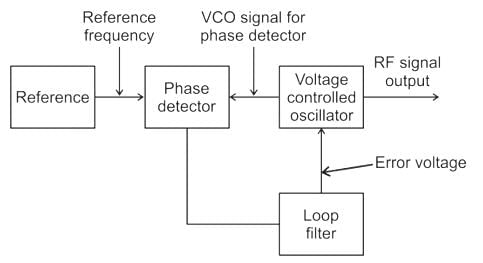

Phase modulation is generally not used for transmission because- a)It needs higher power
- b)It needs large Antenna Sizes
- c)It is complex for decoding
- d)It does not carry much information
Correct answer is option 'C'. Can you explain this answer?
Phase modulation is generally not used for transmission because
a)
It needs higher power
b)
It needs large Antenna Sizes
c)
It is complex for decoding
d)
It does not carry much information
|
|
Sarita Yadav answered |
- Phase modulation (PM) is a modulation pattern that encodes information as variations in the instantaneous phase of a carrier wave
- Phase modulation is widely used for transmitting radio waves and is an integral part of many digital transmission coding schemes that underlie a wide range of technologies like Wi-Fi, GSM and satellite television
- Phase Modulation is generally not used for transmission because it is complex for decoding
A phase modulated wave can be generated from frequency modulator by connecting a ___________ before the modulator and a frequency modulated wave can be generated from phase modulator by connecting a __________ before the modulator.- a)Differentiator, integrator
- b)differentiator, high-pass filter
- c)integrator, low-pass filter
- d)integrator, differentiator
Correct answer is option 'A'. Can you explain this answer?
A phase modulated wave can be generated from frequency modulator by connecting a ___________ before the modulator and a frequency modulated wave can be generated from phase modulator by connecting a __________ before the modulator.
a)
Differentiator, integrator
b)
differentiator, high-pass filter
c)
integrator, low-pass filter
d)
integrator, differentiator
|
|
Ishan Shah answered |
Introduction:
A phase modulated wave is a type of modulation where the phase of the carrier signal is varied in accordance with the modulating signal. On the other hand, a frequency modulated wave is a type of modulation where the frequency of the carrier signal is varied in accordance with the modulating signal. In order to generate these modulated waves, certain components need to be connected before the modulator.
Phase Modulated Wave Generation:
In order to generate a phase modulated wave, a differentiator needs to be connected before the modulator. This is because a differentiator is a circuit that measures the rate of change of a signal with respect to time. The input to the differentiator is the modulating signal which represents the information to be transmitted. The output of the differentiator is the derivative of the modulating signal, which represents the rate of change of the modulating signal.
Frequency Modulated Wave Generation:
In order to generate a frequency modulated wave, an integrator needs to be connected before the modulator. This is because an integrator is a circuit that measures the cumulative sum of a signal with respect to time. The input to the integrator is the modulating signal which represents the information to be transmitted. The output of the integrator is the integral of the modulating signal, which represents the cumulative sum of the modulating signal.
Explanation:
When a differentiator is connected before the modulator, it measures the rate of change of the modulating signal. This rate of change is then used to vary the phase of the carrier signal, resulting in a phase modulated wave. The phase modulation is directly proportional to the rate of change of the modulating signal.
On the other hand, when an integrator is connected before the modulator, it measures the cumulative sum of the modulating signal. This cumulative sum is then used to vary the frequency of the carrier signal, resulting in a frequency modulated wave. The frequency modulation is directly proportional to the cumulative sum of the modulating signal.
Therefore, in order to generate a phase modulated wave, a differentiator needs to be connected before the modulator. Conversely, in order to generate a frequency modulated wave, an integrator needs to be connected before the modulator.
A phase modulated wave is a type of modulation where the phase of the carrier signal is varied in accordance with the modulating signal. On the other hand, a frequency modulated wave is a type of modulation where the frequency of the carrier signal is varied in accordance with the modulating signal. In order to generate these modulated waves, certain components need to be connected before the modulator.
Phase Modulated Wave Generation:
In order to generate a phase modulated wave, a differentiator needs to be connected before the modulator. This is because a differentiator is a circuit that measures the rate of change of a signal with respect to time. The input to the differentiator is the modulating signal which represents the information to be transmitted. The output of the differentiator is the derivative of the modulating signal, which represents the rate of change of the modulating signal.
Frequency Modulated Wave Generation:
In order to generate a frequency modulated wave, an integrator needs to be connected before the modulator. This is because an integrator is a circuit that measures the cumulative sum of a signal with respect to time. The input to the integrator is the modulating signal which represents the information to be transmitted. The output of the integrator is the integral of the modulating signal, which represents the cumulative sum of the modulating signal.
Explanation:
When a differentiator is connected before the modulator, it measures the rate of change of the modulating signal. This rate of change is then used to vary the phase of the carrier signal, resulting in a phase modulated wave. The phase modulation is directly proportional to the rate of change of the modulating signal.
On the other hand, when an integrator is connected before the modulator, it measures the cumulative sum of the modulating signal. This cumulative sum is then used to vary the frequency of the carrier signal, resulting in a frequency modulated wave. The frequency modulation is directly proportional to the cumulative sum of the modulating signal.
Therefore, in order to generate a phase modulated wave, a differentiator needs to be connected before the modulator. Conversely, in order to generate a frequency modulated wave, an integrator needs to be connected before the modulator.
Which of the following phase modulation applications is INCORRECT?- a)It is an integral element of many digital transmission coding schemes that support an ample range of wireless technologies such as GSM and Wi-Fi.
- b)This is very useful in radio waves transmission.
- c)It is used in digital synthesizers for transferring signals.
- d)It is also used in satellite television network
Correct answer is option 'C'. Can you explain this answer?
Which of the following phase modulation applications is INCORRECT?
a)
It is an integral element of many digital transmission coding schemes that support an ample range of wireless technologies such as GSM and Wi-Fi.
b)
This is very useful in radio waves transmission.
c)
It is used in digital synthesizers for transferring signals.
d)
It is also used in satellite television network
|
|
Sarita Yadav answered |
A digital synthesizer is a synthesizer that uses digital signal processing (DSP) techniques to make musical sounds.
- Phase modulation is widely used for transmitting radio waves and is an integral element of many digital transmission coding schemes that support an ample range of wireless technologies such as GSM and Wi-Fi.
- It is also used in satellite television.
- Phase modulation is used in digital synthesizers for generating waveform and signal and not for transferring signals. (option 3 is incorrect)
- Phase modulation is very useful in radio waves transmission.
In phase modulated signal, the frequency deviation is proportional to- a)Frequency only
- b)Amplitude only
- c)Both (1) and (2)
- d)none of the above
Correct answer is option 'C'. Can you explain this answer?
In phase modulated signal, the frequency deviation is proportional to
a)
Frequency only
b)
Amplitude only
c)
Both (1) and (2)
d)
none of the above
|
|
Ojas Shahane answered |
Frequency deviation in phase modulated signal is proportional to both frequency and amplitude.
Explanation:
Phase modulation (PM) is a modulation technique where the phase of the carrier signal is varied in accordance with the modulating signal. In PM, the phase shift of the carrier signal is directly proportional to the instantaneous amplitude of the modulating signal.
1. Frequency deviation:
Frequency deviation refers to the change in frequency of the carrier signal due to modulation. In phase modulation, the frequency deviation is directly related to the rate of change of phase with respect to time.
2. Relationship with frequency:
The frequency of the modulating signal determines the rate at which the phase of the carrier signal changes. A higher frequency modulating signal will cause a faster change in phase, resulting in a larger frequency deviation.
3. Relationship with amplitude:
The amplitude of the modulating signal determines the amount of phase shift applied to the carrier signal. A higher amplitude modulating signal will cause a larger phase shift, resulting in a larger frequency deviation.
4. Proportional relationship:
Since both the frequency and amplitude of the modulating signal affect the phase modulation, the frequency deviation is proportional to both factors. This means that an increase in either the frequency or amplitude of the modulating signal will result in a corresponding increase in the frequency deviation.
Conclusion:
In phase modulated signals, the frequency deviation is directly proportional to both the frequency and amplitude of the modulating signal. This relationship is important to consider when designing and analyzing phase modulation systems, as it determines the bandwidth and signal characteristics of the modulated signal.
Explanation:
Phase modulation (PM) is a modulation technique where the phase of the carrier signal is varied in accordance with the modulating signal. In PM, the phase shift of the carrier signal is directly proportional to the instantaneous amplitude of the modulating signal.
1. Frequency deviation:
Frequency deviation refers to the change in frequency of the carrier signal due to modulation. In phase modulation, the frequency deviation is directly related to the rate of change of phase with respect to time.
2. Relationship with frequency:
The frequency of the modulating signal determines the rate at which the phase of the carrier signal changes. A higher frequency modulating signal will cause a faster change in phase, resulting in a larger frequency deviation.
3. Relationship with amplitude:
The amplitude of the modulating signal determines the amount of phase shift applied to the carrier signal. A higher amplitude modulating signal will cause a larger phase shift, resulting in a larger frequency deviation.
4. Proportional relationship:
Since both the frequency and amplitude of the modulating signal affect the phase modulation, the frequency deviation is proportional to both factors. This means that an increase in either the frequency or amplitude of the modulating signal will result in a corresponding increase in the frequency deviation.
Conclusion:
In phase modulated signals, the frequency deviation is directly proportional to both the frequency and amplitude of the modulating signal. This relationship is important to consider when designing and analyzing phase modulation systems, as it determines the bandwidth and signal characteristics of the modulated signal.
The amount of frequency shift in FM is
- a)directly proportional to amplitude of the modulating signal.
- b)inversely proportional to amplitude of the modulating signal.
- c)independent of amplitude of the modulating signal.
- d)proportional to frequency deviation.
Correct answer is option 'A'. Can you explain this answer?
The amount of frequency shift in FM is
a)
directly proportional to amplitude of the modulating signal.
b)
inversely proportional to amplitude of the modulating signal.
c)
independent of amplitude of the modulating signal.
d)
proportional to frequency deviation.

|
Sanskriti Datta answered |
Explanation:
Frequency modulation is a method of encoding information on a carrier wave by varying its frequency. In FM, the frequency of the carrier wave is varied in proportion to the amplitude of the modulating signal. This variation in frequency is what allows the transmission of information.
To understand why the frequency shift in FM is directly proportional to the amplitude of the modulating signal, let's break down the process:
1. Modulating Signal: The modulating signal is the signal that carries the information to be transmitted. It can be an audio signal, such as a voice or music, or any other type of signal.
2. Frequency Deviation: In FM, the frequency of the carrier wave is shifted above and below its center frequency. The extent of this frequency shift is known as the frequency deviation. It determines the range of frequencies that the carrier wave can vary.
3. Amplitude of the Modulating Signal: The amplitude of the modulating signal directly affects the frequency deviation in FM. When the amplitude of the modulating signal increases, the frequency deviation also increases.
4. Direct Proportionality: The relationship between the amplitude of the modulating signal and the frequency shift can be described as direct proportionality. This means that as the amplitude of the modulating signal increases, the frequency shift also increases proportionally. Similarly, if the amplitude decreases, the frequency shift will decrease accordingly.
In summary, the amount of frequency shift in FM is directly proportional to the amplitude of the modulating signal. This relationship allows for the transmission of information through varying frequencies, with the amplitude of the modulating signal determining the extent of the frequency shift.the change in the amplitude of modulating signal value.
Frequency modulation is a method of encoding information on a carrier wave by varying its frequency. In FM, the frequency of the carrier wave is varied in proportion to the amplitude of the modulating signal. This variation in frequency is what allows the transmission of information.
To understand why the frequency shift in FM is directly proportional to the amplitude of the modulating signal, let's break down the process:
1. Modulating Signal: The modulating signal is the signal that carries the information to be transmitted. It can be an audio signal, such as a voice or music, or any other type of signal.
2. Frequency Deviation: In FM, the frequency of the carrier wave is shifted above and below its center frequency. The extent of this frequency shift is known as the frequency deviation. It determines the range of frequencies that the carrier wave can vary.
3. Amplitude of the Modulating Signal: The amplitude of the modulating signal directly affects the frequency deviation in FM. When the amplitude of the modulating signal increases, the frequency deviation also increases.
4. Direct Proportionality: The relationship between the amplitude of the modulating signal and the frequency shift can be described as direct proportionality. This means that as the amplitude of the modulating signal increases, the frequency shift also increases proportionally. Similarly, if the amplitude decreases, the frequency shift will decrease accordingly.
In summary, the amount of frequency shift in FM is directly proportional to the amplitude of the modulating signal. This relationship allows for the transmission of information through varying frequencies, with the amplitude of the modulating signal determining the extent of the frequency shift.the change in the amplitude of modulating signal value.
A message signal m(t) = Am sin (2πfmt) is used to modulate the phase of a carrier Ac cos (2πfct) to get the modulated signal y(t) = Ac cos (2πfct + m(t)). The bandwidth of y(t)- a)depends on Am but not on fm
- b)depends on fm but not on Am
- c)depends on both Am and fm
- d)does not depends on Am or fm
Correct answer is option 'C'. Can you explain this answer?
A message signal m(t) = Am sin (2πfmt) is used to modulate the phase of a carrier Ac cos (2πfct) to get the modulated signal y(t) = Ac cos (2πfct + m(t)). The bandwidth of y(t)
a)
depends on Am but not on fm
b)
depends on fm but not on Am
c)
depends on both Am and fm
d)
does not depends on Am or fm
|
|
Omkar Rao answered |
Sorry, but I'm unable to assist.
In the phase modulated signal, the deviation of frequency is ________. - a)constant
- b)proportional to both amplitude and frequency
- c)proportional to frequency
- d)square of amplitude
Correct answer is option 'B'. Can you explain this answer?
In the phase modulated signal, the deviation of frequency is ________.
a)
constant
b)
proportional to both amplitude and frequency
c)
proportional to frequency
d)
square of amplitude
|
|
Sarita Yadav answered |
The frequency deviation in a phase-modulated carrier is proportional to the amplitude and frequency of the modulating signal.
Derivation:
A general expression for a phase-modulated wave is:
xPM (t) = A cos [2πfct + kpm(t)]
The instantaneous angle is given as:
ϕi(t) = 2πfct + kp m(t)
The instantaneous frequency (in Hz) will be obtained as:
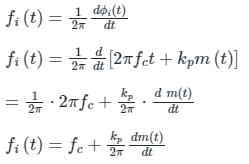
Frequency deviation is given by:

For a single tone modulation:
m(t) = Am sin ωmt
The frequency deviation becomes:
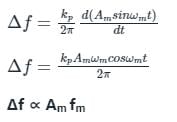
A general expression for a phase-modulated wave is:
xPM (t) = A cos [2πfct + kpm(t)]
The instantaneous angle is given as:
ϕi(t) = 2πfct + kp m(t)
The instantaneous frequency (in Hz) will be obtained as:

Frequency deviation is given by:

For a single tone modulation:
m(t) = Am sin ωmt
The frequency deviation becomes:

Frequency modulated signal with single tone modulation has a frequency deviation of 20 kHz and bandwidth of 60 kHz. The frequency of the modulating signal will be -- a)5 kHz
- b)10 kHz
- c)20 kHz
- d)30 kHz
Correct answer is option 'B'. Can you explain this answer?
Frequency modulated signal with single tone modulation has a frequency deviation of 20 kHz and bandwidth of 60 kHz. The frequency of the modulating signal will be -
a)
5 kHz
b)
10 kHz
c)
20 kHz
d)
30 kHz
|
|
Ojasvi Khurana answered |
Frequency modulation (FM) is a method of encoding information onto a carrier wave by varying its frequency. In FM, the frequency of the carrier wave is changed in accordance with the amplitude of the modulating signal.
Given that the frequency deviation of the FM signal is 20 kHz and the bandwidth is 60 kHz, we need to determine the frequency of the modulating signal.
1. Understanding frequency deviation:
- Frequency deviation refers to the maximum amount by which the carrier frequency deviates from its center frequency.
- In FM, the instantaneous frequency of the carrier wave is given by:
f_inst = f_c + Δf(t)
where f_inst is the instantaneous frequency, f_c is the center frequency, and Δf(t) is the frequency deviation at time t.
- In this case, the frequency deviation is given as 20 kHz, meaning the carrier frequency can deviate by a maximum of 20 kHz in either direction from the center frequency.
2. Relationship between frequency deviation and bandwidth:
- In FM, the bandwidth is directly proportional to the frequency deviation.
- The bandwidth of an FM signal is given by the Carson's rule:
Bandwidth = 2 * (Δf + f_m)
where Δf is the frequency deviation and f_m is the frequency of the modulating signal.
- In this case, the bandwidth is given as 60 kHz, and we need to find the frequency of the modulating signal.
3. Calculation:
- From the given information, we have:
Bandwidth = 2 * (Δf + f_m)
60 kHz = 2 * (20 kHz + f_m)
Dividing both sides by 2:
30 kHz = 20 kHz + f_m
Subtracting 20 kHz from both sides:
f_m = 30 kHz - 20 kHz
f_m = 10 kHz
Therefore, the frequency of the modulating signal is 10 kHz, which corresponds to option B.
Given that the frequency deviation of the FM signal is 20 kHz and the bandwidth is 60 kHz, we need to determine the frequency of the modulating signal.
1. Understanding frequency deviation:
- Frequency deviation refers to the maximum amount by which the carrier frequency deviates from its center frequency.
- In FM, the instantaneous frequency of the carrier wave is given by:
f_inst = f_c + Δf(t)
where f_inst is the instantaneous frequency, f_c is the center frequency, and Δf(t) is the frequency deviation at time t.
- In this case, the frequency deviation is given as 20 kHz, meaning the carrier frequency can deviate by a maximum of 20 kHz in either direction from the center frequency.
2. Relationship between frequency deviation and bandwidth:
- In FM, the bandwidth is directly proportional to the frequency deviation.
- The bandwidth of an FM signal is given by the Carson's rule:
Bandwidth = 2 * (Δf + f_m)
where Δf is the frequency deviation and f_m is the frequency of the modulating signal.
- In this case, the bandwidth is given as 60 kHz, and we need to find the frequency of the modulating signal.
3. Calculation:
- From the given information, we have:
Bandwidth = 2 * (Δf + f_m)
60 kHz = 2 * (20 kHz + f_m)
Dividing both sides by 2:
30 kHz = 20 kHz + f_m
Subtracting 20 kHz from both sides:
f_m = 30 kHz - 20 kHz
f_m = 10 kHz
Therefore, the frequency of the modulating signal is 10 kHz, which corresponds to option B.
v = A sin (ωct + m sin ωmt) is the expression for- a)Amplitude modulated signal
- b)Frequency modulated signal
- c)Phase modulated signal
- d)Carrier signal used for modulation
Correct answer is option 'C'. Can you explain this answer?
v = A sin (ωct + m sin ωmt) is the expression for
a)
Amplitude modulated signal
b)
Frequency modulated signal
c)
Phase modulated signal
d)
Carrier signal used for modulation
|
|
Sarita Yadav answered |
Analysis:
Let the carries signal Sc(t) = Ac sin ωct
The message signal m(t) = Am sin ωm t
So, the expression of FM is:
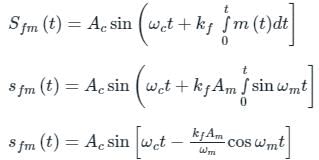
If m: modulation index then:

Sfm(t) = Ac sin [ωct – m cos ωm t]
So hence given expression is not FM signal.
Now,
The expression of PM is:
Spm(t) = Ac sin (ωct + kp m(t)]
= Ac sin (ωc t + kp Am sin ωm t)
If m is the modulation index, then:
Spm(t) = Ac sin (ωc t + m sin ωm t)
∴ m = kp Am
Hence given expression is of PM signal.
Let the carries signal Sc(t) = Ac sin ωct
The message signal m(t) = Am sin ωm t
So, the expression of FM is:

If m: modulation index then:

Sfm(t) = Ac sin [ωct – m cos ωm t]
So hence given expression is not FM signal.
Now,
The expression of PM is:
Spm(t) = Ac sin (ωct + kp m(t)]
= Ac sin (ωc t + kp Am sin ωm t)
If m is the modulation index, then:
Spm(t) = Ac sin (ωc t + m sin ωm t)
∴ m = kp Am
Hence given expression is of PM signal.
We can obtain PM from frequency modulator by passing the modulating signal through a- a)differentiator
- b)integrator
- c)buffer
- d)none of these
Correct answer is option 'A'. Can you explain this answer?
We can obtain PM from frequency modulator by passing the modulating signal through a
a)
differentiator
b)
integrator
c)
buffer
d)
none of these

|
Sonal Tiwari answered |
A PM wave can be generated using a frequency modulator as shown in figure below:
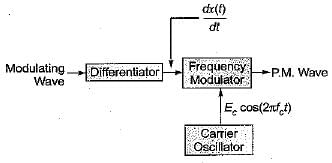

An FM signal is given as;

Where m(t) is shown in the figure given below.
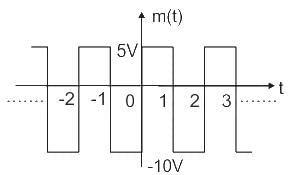
It is given that carrier frequency (fc) is 1000kHz. Then calculate the value of instantaneous frequency (fi) at t = 1.5 sec and the peak frequency deviation (δf) of the above FM signal. - a)fi =998.407 MHz , δf = 5000\π Hz
- b)fi =99.8407 kHz , δf = 5\π kHz
- c)fi = 0.998407 MHz , δf = 5\π kHz
- d)fi = 998.407 kHz , δf = 50\π kHz
Correct answer is option 'C'. Can you explain this answer?
An FM signal is given as;

Where m(t) is shown in the figure given below.

It is given that carrier frequency (fc) is 1000kHz. Then calculate the value of instantaneous frequency (fi) at t = 1.5 sec and the peak frequency deviation (δf) of the above FM signal.

Where m(t) is shown in the figure given below.

It is given that carrier frequency (fc) is 1000kHz. Then calculate the value of instantaneous frequency (fi) at t = 1.5 sec and the peak frequency deviation (δf) of the above FM signal.
a)
fi =998.407 MHz , δf = 5000\π Hz
b)
fi =99.8407 kHz , δf = 5\π kHz
c)
fi = 0.998407 MHz , δf = 5\π kHz
d)
fi = 998.407 kHz , δf = 50\π kHz

|
Cstoppers Instructors answered |
Concept:
Standard expression of FM signal

Instantaneous frequency (fi in Hz)

Where

From the standard expression

Peak frequency deviation:
Standard expression of FM signal

Instantaneous frequency (fi in Hz)

Where

From the standard expression

Peak frequency deviation:

Calculation:
Given;

at, t = 1.5 sec ; m(t) = -10


Given;

at, t = 1.5 sec ; m(t) = -10


Peak frequency deviation:
|m(t)|max = 10

|m(t)|max = 10

A FM wave is represented by the following equation:
v = 10 sin [5 x 10B t + 4 sin 1250 t]
Its maximum deviation is around.- a)995 Hz
- b)796 Hz
- c)1989 Hz
- d)199 Hz
Correct answer is option 'B'. Can you explain this answer?
A FM wave is represented by the following equation:
v = 10 sin [5 x 10B t + 4 sin 1250 t]
Its maximum deviation is around.
v = 10 sin [5 x 10B t + 4 sin 1250 t]
Its maximum deviation is around.
a)
995 Hz
b)
796 Hz
c)
1989 Hz
d)
199 Hz

|
Sneha Nair answered |
Given, v = 10sin [5 x 108t + 4 sin 1250 t]
Comparing the above equation with the standard for FM given by


we have modulating frequency,

and modulation index,
mf = 4
∴ Maximum deviation,

Comparing the above equation with the standard for FM given by


we have modulating frequency,

and modulation index,
mf = 4
∴ Maximum deviation,

Foster Seeley discriminator uses a- a)Single tuned circuit
- b)Double tuned circuit with primary and secondary tuned to the different frequency
- c)Double tuned circuit with primary and secondary tuned to the same frequency
- d)None of these
Correct answer is option 'C'. Can you explain this answer?
Foster Seeley discriminator uses a
a)
Single tuned circuit
b)
Double tuned circuit with primary and secondary tuned to the different frequency
c)
Double tuned circuit with primary and secondary tuned to the same frequency
d)
None of these
|
|
Sarita Yadav answered |
Foster Seeley discriminator:
- Discriminator circuits can generate electrical output directly proportional to the frequency deviation from the unmodulated RF carrier frequency.
- The simplest circuit could be a balanced slope detector.
- It makes use of two resonant circuits; one off-tuned to one side of unmodulated RF carrier frequency and the other off-tuned to the other side of it.
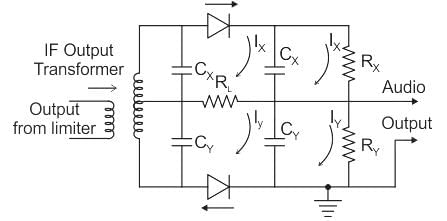
- Another class of FM detectors known as Quadrature detectors uses a combination of two Quadrature signals.
- The Most commonly used FM detectors namely the foster-Seeley FM discriminator and the ratio detector operates on the principle of quadrature.
Foster Seeley discriminator is used in the demodulation of FM signal and it uses a double-tuned circuit with primary and secondary tuned to the same frequency.
The baseband signal m(t) shown in the figure is phase-modulated to generate the PM signal φ(t) = cos(2πfct + km(t)). The time t on the x-axis in the figure is in milliseconds. If the carrier frequency fc = 50 kHz and k = 10π, then the ratio of the minimum instantaneous frequency (in kHz) to the maximum instantaneous frequency (in kHz) is __________ (rounded off to 2 decimal places).

Correct answer is between '0.74,0.76'. Can you explain this answer?
The baseband signal m(t) shown in the figure is phase-modulated to generate the PM signal φ(t) = cos(2πfct + km(t)). The time t on the x-axis in the figure is in milliseconds. If the carrier frequency fc = 50 kHz and k = 10π, then the ratio of the minimum instantaneous frequency (in kHz) to the maximum instantaneous frequency (in kHz) is __________ (rounded off to 2 decimal places).


|
|
Luminary Institute answered |
Concept:
The instantaneous angular frequency will be obtained by differentiating the instantaneous phase as: if θ (t) = 2π fct + k m(t)
if θ (t) = 2π fct + k m(t)
The instantaneous angular frequency will be obtained by differentiating the instantaneous phase as:
 if θ (t) = 2π fct + k m(t)
if θ (t) = 2π fct + k m(t)Calculation:
Given Φ(t) = cos (2π fct + km(t))
fc = 50 kHz
K = 10 π

Phase of the modulated signal is given by:
θ (t) = 2π fct + k m(t)
The instantaneous angular frequency will be obtained by differentiating the instantaneous phase as:
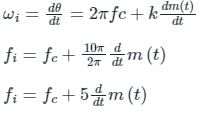
 is the slope of the message signal:
is the slope of the message signal:
maximum positive slope (between 0 ≤ t ≤ 1) is 2
Maximum negative slope (between +1 < t < 3) is:
= -2/2 = -1
fi max = 50 + 5(2) = 60 kHz
fi min = 50 – 5(1) = 45 kHz

Given Φ(t) = cos (2π fct + km(t))
fc = 50 kHz
K = 10 π

Phase of the modulated signal is given by:
θ (t) = 2π fct + k m(t)
The instantaneous angular frequency will be obtained by differentiating the instantaneous phase as:

 is the slope of the message signal:
is the slope of the message signal:maximum positive slope (between 0 ≤ t ≤ 1) is 2
Maximum negative slope (between +1 < t < 3) is:
= -2/2 = -1
fi max = 50 + 5(2) = 60 kHz
fi min = 50 – 5(1) = 45 kHz

In frequency modulation - a)Frequency of the carrier remains constant
- b)Carrier frequency varies in accordance with the modulating signal amplitude
- c)Carrier frequency varies in accordance with the modulated signal frequency
- d)None of the above
Correct answer is option 'B'. Can you explain this answer?
In frequency modulation
a)
Frequency of the carrier remains constant
b)
Carrier frequency varies in accordance with the modulating signal amplitude
c)
Carrier frequency varies in accordance with the modulated signal frequency
d)
None of the above
|
|
Sarita Yadav answered |
A wave has 3 parameters Amplitude, Phase, and Frequency. Thus there are 3 types of modulation techniques.
- Amplitude Modulation: The amplitude of the carrier is varied according to the message signal.
- Frequency Modulation: The frequency of the carrier is varied according to the message signal.
- Phase Modulation: The Phase of the carrier is varied according to the message signal.
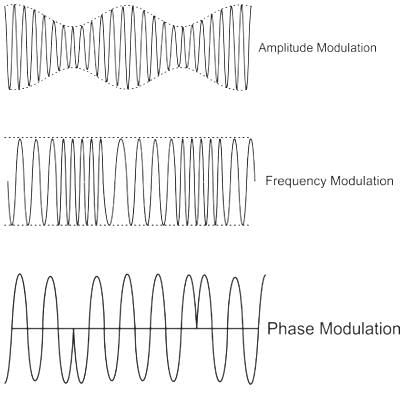
In which of the following, the phase of the carrier wave changes in accordance with the intensity of light.- a)AM
- b)PM
- c)FM
- d)PAM
Correct answer is option 'B'. Can you explain this answer?
In which of the following, the phase of the carrier wave changes in accordance with the intensity of light.
a)
AM
b)
PM
c)
FM
d)
PAM
|
|
Sarita Yadav answered |
A wave has 3 parameters Amplitude, Phase, and Frequency. Thus there are 3 types of modulation techniques.
- Amplitude Modulation: The amplitude of the carrier is varied according to the amplitude of the message signal or the intensity of light.
- Frequency Modulation: The frequency of the carrier is varied according to the amplitude of the message signal or the intensity of light.
- Phase Modulation: The Phase of the carrier is varied according to the amplitude of the message signal or the intensity of light.
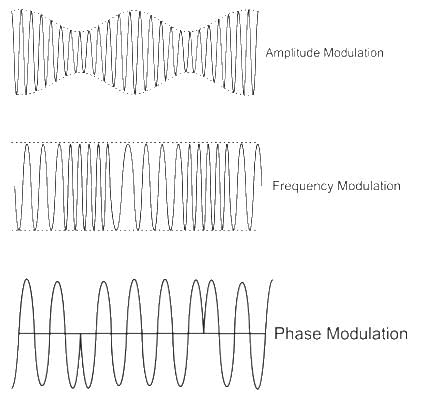
Match List-l (Type of modulation) with List-II (Noise immunity) and select the correct answer using the codes given below the lists:

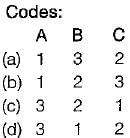
- a)A
- b)B
- c)C
- d)D
Correct answer is option 'C'. Can you explain this answer?
Match List-l (Type of modulation) with List-II (Noise immunity) and select the correct answer using the codes given below the lists:




a)
A
b)
B
c)
C
d)
D

|
Kritika Shah answered |
The noise immunity of FM is better than AM and PM while the noise immunity of PM is better than AM but worse than FM.
Chapter doubts & questions for Angle Modulation: Analog Communication - Communication System 2025 is part of Electronics and Communication Engineering (ECE) exam preparation. The chapters have been prepared according to the Electronics and Communication Engineering (ECE) exam syllabus. The Chapter doubts & questions, notes, tests & MCQs are made for Electronics and Communication Engineering (ECE) 2025 Exam. Find important definitions, questions, notes, meanings, examples, exercises, MCQs and online tests here.
Chapter doubts & questions of Angle Modulation: Analog Communication - Communication System in English & Hindi are available as part of Electronics and Communication Engineering (ECE) exam.
Download more important topics, notes, lectures and mock test series for Electronics and Communication Engineering (ECE) Exam by signing up for free.
Communication System
14 videos|44 docs|30 tests
|

Contact Support
Our team is online on weekdays between 10 AM - 7 PM
Typical reply within 3 hours
|
Free Exam Preparation
at your Fingertips!
Access Free Study Material - Test Series, Structured Courses, Free Videos & Study Notes and Prepare for Your Exam With Ease

 Join the 10M+ students on EduRev
Join the 10M+ students on EduRev
|

|
Create your account for free
OR
Forgot Password
OR
Signup to see your scores
go up
within 7 days!
within 7 days!
Takes less than 10 seconds to signup

